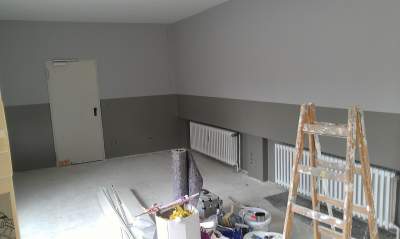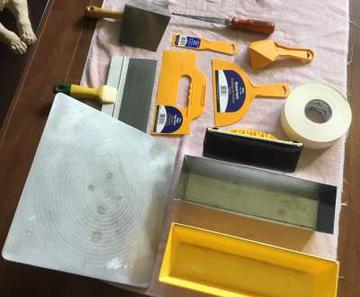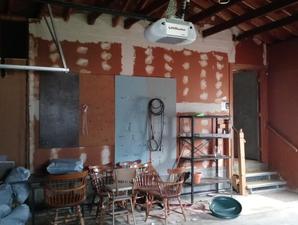When is Asbestos in Residential Drywall Not Regulated?
Is there asbestos in drywall?
Asbestos was added to drywall joint mudding compound in the 1960s are early 1970s and is sometimes detected in earlier or later construction. This mud compound can contain anywhere from a trace percentage (0.2% to as much as 10% asbestos).
Asbestos is less common in associated paper and mesh seaming tapes and extremely rare in the drywall but should be tested as well.
Asbestos occurs rarely in old paint and wallpaper or other laminates.
When homeowners are doing renovations in their own home or are having contractors do renovations, it’s a good idea to have the joint compound tested for asbestos and in certain circumstances, it is legally required.
To assist homeowners, contractors and others navigate the various scenarios involving asbestos in drywall joint compound in homes, Tri-Tech is providing an explanation of the various regulations and scenarios that could apply to home renovations involving drywall.
EPA Regulations for Asbestos
EPA regulations for asbestos are prescribed to protect general human occupant health and the environment.
Under a 1994 EPA Ruling, the sample can be composited and the asbestos content (percentage) of the wallboard system as a whole can be used for asbestos-containing material determination.
Where non-asbestos drywall can be determined to be well over twice the thickness of the joint compound not exceeding 2%, no re-analysis is required as it can be determined that the composite result would not exceed 1% asbestos.
Where the wallboard/joint compound building system as a whole is considered non-asbestos, abatement of this material prior to renovation is not required under the NESHAP asbestos standard for renovation/demolition. Furthermore, EPA does not have jurisdiction over residential projects involving demolition (unless the building is being converted to or used for non-residential purposes or if the building is being demolished). This means that removing of drywall with the asbestos joint compound would not generally require abatement methods to be protective of the home’s occupants as long as methods typical of work in occupied residences are utilized.
OSHA Regulations for Asbestos in Drywall
OSHA regulations for asbestos are prescribed to protect workers who have hands-on or nearby exposures to asbestos in their workplace. Unlike EPA’s rule allowing compositing, the asbestos-containing material designation is unchanged for OSHA regulation purposes.
The drywall joint compound and drywall are treated as separate materials so the 2% asbestos joint compound remains a regulated asbestos-containing building material. Disturbance or removal of asbestos joint compound is considered OSHA “Class II work” (OSHA has defined four types of work ranging from Class I for the highest risk work to Class IV for the lowest risk work.
The most stringent controls and training requirements apply for Class I and they are proportionately reduced for the lower Classes of work).
Therefore, to comply with OSHA requirements, asbestos drywall joint compound disturbance/removal must be performed by renovation contractors that have OSHA Class II training and utilize the prescribed Class II methods or by an asbestos abatement contractor using Class II (or better work) practices. It can be inferred then that non-removal practices such as demolition of an entire structure, which does not involve direct worker disturbance, would not require abatement to comply with OSHA requirements.
You can learn more about the OSHA Class types of work here.
Compliance with these requirements is a responsibility of the contractor and not the homeowner. Furthermore, self-employed contractors performing asbestos removal work are exempt from OSHA regulations (assuming they assert they are acting as an owner and not an employee).
In certain circumstances, painted drywall with asbestos joint compound (the paint serves to protect the joint compound and prevent it from becoming friable) can be removed without significant disturbance and therefore not trigger Class II requirements. This can be done in circumstances where joint compound is only used at drywall seams and to cover nail holes and the installation of 4’x8’ sheets of drywall can be visualized.
Under this method, wallboard is removed in an intact manner by sawcutting or hand scoring the drywall at staggered four-foot intervals in between the vertical and horizontal mudded joints to allow access from behind.
Gentle flexing and prying of the wallboard will typically enable removal without causing significant disturbance to the joint compound.
The boards can be manually pried loose from the studs behind to remove them in a substantially intact form. By this means, with the seams wetted as an additional precaution, the boards can be folded over at the seams and removed by hand, resulting in a substantially intact removal.
In the opinion of Tri-Tech, this removal method could be accomplished by workers with OSHA two-hour Asbestos Awareness training and Class IV cleanup procedures supervised by an OSHA trained competent person.
DOT/Misc. Waste Regulations
Asbestos-containing waste materials are generally unregulated within the confines of a home.
However, waste materials once transported off the property become regulated under local, state and federal transportation and waste regulations.
Generally, asbestos drywall demolition waste if removed substantially intact and not made friable is considered Type III waste and can be disposed of in a roll-off box or similar construction waste receptacle.
Small quantities of such waste are typically permitted to be disposed of as Type II (general refuse) waste with streetside household municipal collection. However, this should be verified by the homeowner as local regulations and waste disposal requirements may vary.
If the demolition debris becomes pulverized and friable and the drywall wastes must be bagged for disposal, it is considered a Type II asbestos waste that must be properly disposed of by an approved asbestos waste hauler or an asbestos abatement contractor.
Homeowner Exemption
Notwithstanding the health risks, a homeowner may disturb or remove any form of asbestos from their home and be exempt from all regulation. However, waste disposal regulations will apply to the homeowner as described above. A contractor doing work in a home where the homeowner has performed the removal has the discretion and the right to request that the homeowner provide an Asbestos Clearance (inspection and air testing to prove that no asbestos hazard remains) or to retain someone to perform such clearance work on their behalf. If a homeowner elects to remove the drywall themselves, it is recommended that they use the staggered removal methods described above that minimizes disturbance.
But Is It Really Dangerous Asbestos?
At times, the laboratory result will report a concentration of asbestos at a level of 2-3% and sometimes up to 5% for a joint compound layer. As explained above, the EPA and OSHA threshold for regulation of asbestos is a concentration of asbestos exceeding 1% by a laboratory method known as PLM. This standard of 1% was a somewhat arbitrary and a convenient number set by regulators. However, the effective detection limit (sensitivity) of the PLM analytical method is 2%. At this low level of detection, the accuracy of a lab analyst’s result is typically +/- 1-2% and a result of between 1 and 2 percent is not possible with this method because visual estimation methods are used. Therefore, this result can be considered “inconclusive” and this designation is sometimes applied to results up to 5%. In these cases, a more sensitive analytical method may be utilized to attempt to better characterize the asbestos content of the inconclusive results.
This method is commonly known as “point counting” and has an effective detection limit of approximately 0.25 % and better resolution of results (to a tenth of a percent).
This additional “point count” testing may be considered to determine the actual numeric concentration of the asbestos content as resolved by a more sensitive method compared to the visual estimation methods used by the PLM method.
This would involve the retesting of samples analyzed by the point counting method. If the result is less than 1% (for example 0.8%), the material would be determined as non-asbestos and therefore not regulated by OSHA .
If the result is greater than 1% (for example 1.1%), the joint compound material would be treated as asbestos.
In the experience of Tri-Tech, joint compound samples reported at 2% have a roughly 40-50% chance of being reported as <1% by point counting methods . Materials reported at 3% have an approximate 30% chance of being reported as <1% and samples at 5% approximately a 5-10% chance of being reported as <1%.
Original EPA guidance recommended point-counting materials with results below 10%. However, in the opinion of Tri-Tech, this guidance was overly conservative and underestimated the ability of experienced microscopists to accurately “calibrate” their visual powers of estimation at lower concentrations. In unusual circumstances, it might be worthwhile from a cost-benefit rationale to point count materials reported as 3-5% asbestos by PLM.
Have any questions? We're happy to help.
How Common is Asbestos in Drywall?
Asbestos becomes regulated at concentrations exceeding 1%. At concentrations, of less than 1%, asbestos is typically unregulated and can be treated as non-asbestos although some precautions may be appropriate.
Similarly, typical thin layers of joint compound not exceeding 1/4th of the drywall thickness containing up to 5% asbestos will not exceed the 1% threshold for a composite result.
If desired, the composite result can be determined by additional laboratory analyses rather than inference and this is recommended when additional assurances are needed for regulatory or recordkeeping purposes.
EPA based the decision to exempt ACM joint mud wallboard circumstances based on practical enforcement issues rather than epidemiological data stating the difficulties in quantifying all the joints and nail holes in a wall system to determine if the 160 sq.ft. threshold has been exceeded. EPA did not want the associated large volumes of non-ACM drywall going to asbestos landfills unnecessarily.
Homeowners should consider that, while we tend to simply things by regulating asbestos based on the percentage present (over or under 1%), the actual health exposure risk is based more on the amount and duration of disturbance of an asbestos material than its percentage
four sheets of 4x8 drywall hung horizontally and seamed up with joint compound in a garage




